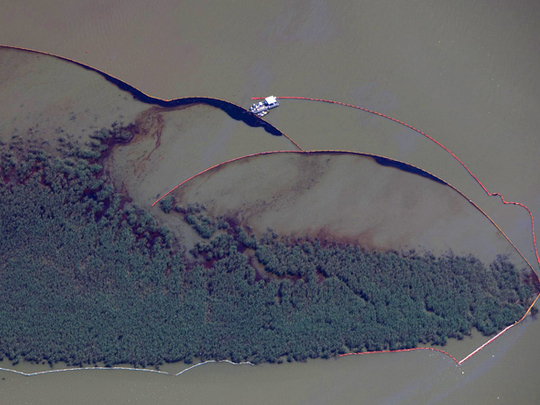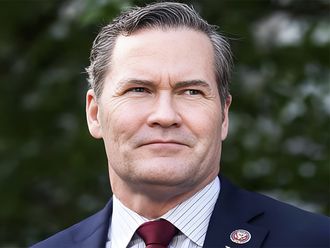
Washington/Venice: US President Barack Obama fended off criticism he has been too slow to respond to a massive oil spill in the Gulf of Mexico as BP made headway in plugging its ruptured deep-sea well.
The disaster has now eclipsed the previous worst US oil spill, the Exxon Valdez disaster that tarnished the Alaska coast in 1989, according to new US government estimates of the amount of oil spewing into the Gulf.
With Americans divided over his handling of the five-week-old spill, Obama vowed to hold BP accountable and said he was "angry and frustrated" at the London-based company's failure to plug the leak.
"In case you're wondering who's responsible, I take responsibility," he told a White House news conference. "It is my job to make sure everything is done to shut this down."
He announced a six-month extension of the moratorium on permits for new deepwater oil drilling while a commission investigates the causes of the disaster, and ordered 33 deepwater exploratory wells in the Gulf of Mexico to suspend work while they meet new safety requirements.
The move is a setback to offshore exploration and a potential blow to Obama's efforts to rejig US energy policy.
The political fallout from the spill also claimed its highest-profile victim as the head of the government agency that oversees offshore oil drilling resigned.
BP Managing Director Robert Dudley said a complex "top kill" operation started on Wednesday to try to halt the seabed well's flow by pumping heavy drilling fluids into it was "moving the way we want it to."
Dudley later told US television networks it would be another 24-48 hours before the company could tell whether the top kill procedure had worked.
"They're still pumping mud into the wellbore and they're still monitoring it ... it is ongoing," US Coast Guard Admiral Thad Allen, who is leading the oil spill response operation, told reporters in Venice, Louisiana.
Million of gallons of oil have poured into the Gulf since an April 20 blast on the Deepwater Horizon rig that killed 11 workers and triggered the spill, soiling 100 miles (160 km) of coastline, threatening some of the country's richest fisheries and endangering a fragile ecosystem already battered by Hurricane Katrina in 2005.
At the White House, Obama repeatedly defended his administration against mounting criticism from Gulf Coast residents that it was too slow to respond to the oil spill and too dependent on BP for solutions.
The spill could turn into a major political liability for Obama ahead of November elections that are widely expected to erode his Democratic Party's control of the US Congress.
"Those who think that we were either slow on our response or lacked urgency don't know the facts," said Obama, who is due to visit the Louisiana Gulf coast on Friday.
"This has been our highest priority since this crisis occurred," he said.
His Republican predecessor, President George W. Bush, was slammed for his administration's slow response to Katrina.
Key energy official resigns
Obama said federal authorities had been in charge of the response to the disaster since day one but had been forced to rely on BP's superior underwater technology.
He also announced that planned exploration off the coast of Alaska would be suspended pending the presidential commission's review, while pending or proposed lease sales in the Gulf of Mexico and off the coast of Virginia would also be scrapped.
Earlier, Interior Secretary Ken Salazar said the head of the Minerals Management Service, Liz Birnbaum, had resigned. Many US lawmakers and environmental groups have blamed the federal agency for lax regulation of offshore drilling rigs and production platforms.
The scale of the Gulf of Mexico spill -- already large -- expanded hugely with new government figures on Thursday that put the flow rate from the ruptured well at as much as four or five times BP's estimate of 5,000 barrels (210,00 gallons/795,000 liters) a day.
BP shares rise
News of progress on plugging the spill, coupled with a nearly 4 percent rise in oil prices, lifted shares of the companies mostly closely tied to the oil spill. BP shares were up nearly 6 per cent in London trading.
Nervous investors have wiped about a quarter, or about $50 billion, off the energy giant's market value since April.
The top kill attempt involves pumping heavy drilling fluids into the top of the well to try to halt the oil flow. If it succeeds in doing this, cement would then be injected to cap the well.
US Geological Survey Director Marcia McNutt said various government teams examining the oil spill estimated the flow ranges from 12,000 barrels (504,000 gallons/1.9 million liters) to 25,000 barrels (1.05 million gallons/3.97 million liters ) per day.
The team's best estimate is 12,000-19,000 barrels per day, though one of three measurement methods the team used returned a high-end rate of 25,000 barrels per day, said McNutt.
BP declined immediate comment on the estimates.
In the previous worst US oil spill, in March 1989, the tanker Exxon Valdez hit an undersea reef in Prince William Sound, Alaska, spilling nearly 260,000 barrels (10.92 million gallons/41.34 million liters) of oil into the sea.
'Two Exxon Valdez Tankers'
Jeremy Symons, senior vice president of the National Wildlife Federation, said the flow estimates from the USGS showed that BP could not be trusted.
"It's as if two Exxon Valdez tankers have already run aground and more are on the way if they don't get this hole plugged," he said.
The Coast Guard's Allen gave the go-ahead for part of a proposed project by state authorities in Louisiana to build up outlying coastal barrier islands to try to stop oil from seeping into fragile marshlands and wildlife refuges.
Louisiana's Republican governor, Bobby Jindal, has accused BP and the Coast Guard of doing "too little, too late" to help defend his state's shoreline, hardest-hit by the oil spill, and of dithering over the state's plan to create the barrier island protective rim.











